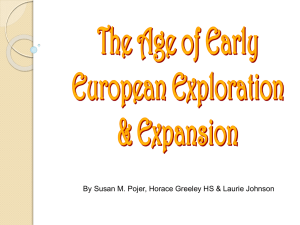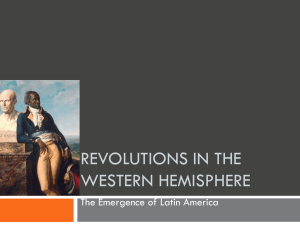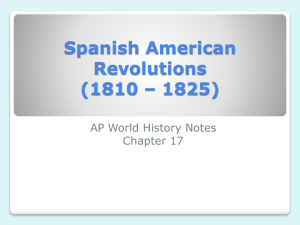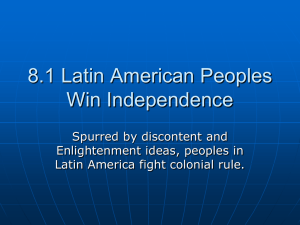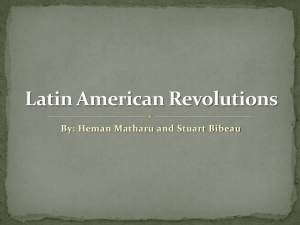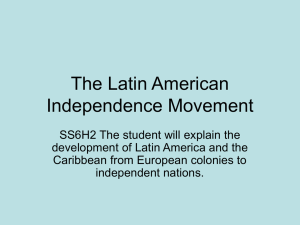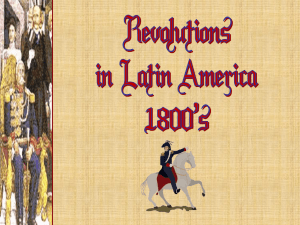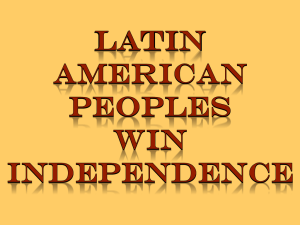Class Notes - Latin American Independence Movements
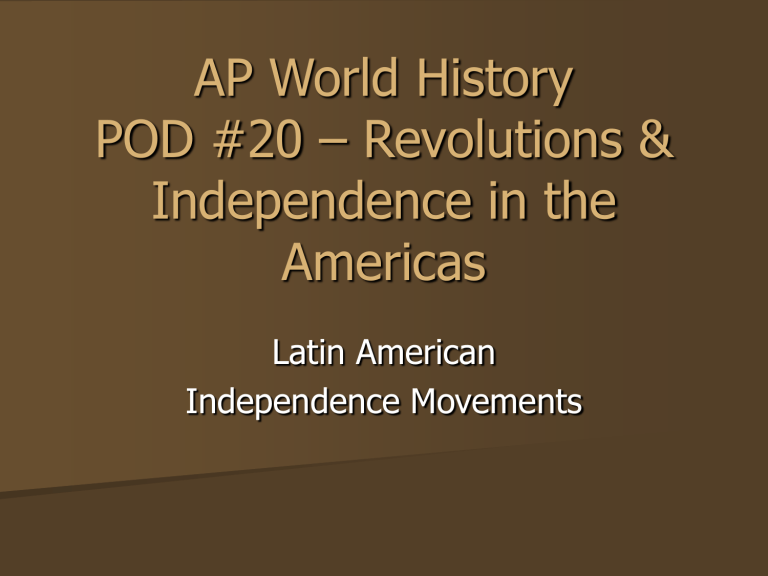
AP World History
POD #20 – Revolutions &
Independence in the
Americas
Latin American
Independence Movements
Class Discussion Notes
Bulliet – “Revolution Spreads, Conservatives
Respond, 1789-1850”, pp. 598-602
Bulliet – “Independence in Latin America,
1800-1830”, pp. 632-637
Historical Setting
“Even as the dictatorship of Napoleon tamed the democratic legacy of the French Revolution, revolutionary ideology was spreading and taking hold in
Europe and the Americas. In Europe the French
Revolution promoted nationalism and republicanism. In the Americas the legacies of the American and French
Revolutions led to a new round of struggles for independence. News of revolutionary events in France destabilized the colonial regime in Saint Domingue
(present-day Haiti), a small French colony on the western half of the island of Hispaniola, and helped initiate the first successful slave rebellion. In Europe, however, the spread of revolutionary fervor was met by the concerted reaction of an alliance of conservative monarchs committed to extinguishing further revolutionary outbreaks.” (Bulliet, p. 598)
Haiti Slavery
French colony of Saint Domingue (Haiti) was one of the richest colonies in the Americas
Sugar, cotton, indigo, and coffee accounted for 2/3 of
France’s tropical imports and generated nearly 1/3 of all
French foreign trade
Wealth depended on brutal slave regime – with its harsh punishments and poor living conditions
High slave mortality rates combined with low fertility rates created a high demand for new African slaves
A majority of the 500,000 slaves were African-born
Haitian Revolution
After the calling of the Estates General in
1789 the wealthy plantation owners sent a delegation to Paris to seek more home rule for the island and greater economic freedom and autonomy
The free mixed-race population (gens de couleur) also sent representatives seeking to limit race discrimination, but not an end to slavery
Outbreak of Revolution
“The political turmoil in France weakened the authority of colonial administrators in Saint Domingue. In the vacuum that resulted, rich planters, poor whites, and the gens de couleur all pursued their narrow interests, engendering an increasingly bitter and confrontational struggle. Given the slaves’ hatred of the brutal regime that oppressed them and the accumulated grievances of the free people of color, there was no way to limit the violence once the control of the slave owners slipped.
When Vincent Oge, leader of the gens de couleur mission to France, returned to Saint Domingue in 1790, the planters captured him and ordered his torture and execution. The free black and slave populations soon repaid this cruelty in kind.” (Bulliet, p. 599)
Touissant L’Ouverture
A former domestic slave
Created a disciplined military force
1794 – the radical French National Convention abolished slavery in all French possessions
He led an attack defeating both his local rivals, as well as a British expeditionary force and took on the Spanish in the colony of Santo Domingo
Freed the slaves of Haiti
Asserted his loyalty to France but gave the
French no role in local governmental affairs
Haitian Independence
“In 1802 Napoleon sent a large military force to reestablish both French colonial authority and slavery in Saint Domingue. At first the French forces were successful, capturing Toussaint and sending him to France, where he died in prison.
Eventually, however, the loss of thousands of lives to yellow fever and the resistance of the revolutionaries turned the tide. In 1804
Touissant’s successors declared independence, and the free republic of Haiti joined the United
States as the second independent nation in the
Western Hemisphere.” (Bulliet, p. 601)
Roots of Latin American Revolution
Enlightenment ideology
American Revolution (Declaration of
Independence)
French Revolution (Declaration of the Rights of
Man and Citizen)
Napoleon’s decision to invade Portugal (1807) and Spain (1808), not revolutionary ideas, created a crisis of legitimacy that undermined the authority of colonial officials and ignited
Latin America’s struggle for independence
Simon Bolivar
Son of wealthy Venezuelan planters
Traveled to Europe to study the works of the Enlightenment
Initially opposed to the abolition of slavery, but he embraced the concept seeing it as means to gain the support slaves and freemen to the cause
Enlisted demobilized English veterans of the Napoleonic Wars
Jose De San Martin
Led a mixed force of Chileans and
Argentinians
Crossed the Andes Mountains to attack
Spanish forces in Chile and Peru (his most effective troops were former slaves)
Gained victory in Chile, but had to turn over command of his troops to Simon
Bolivar in Peru who used them to help defeat the Spanish
Gran Columbia
“After liberating present-day Venezuela,
Columbia, and Equador, Bolivar’s army entered
Peru and Bolivia (colonial Alto Peru) and defeated the last Spanish armies in 1824.
Bolivar and his supporters then attempted to create a confederation of the former Spanish colonies. The first steps were the creation of
Gran Columbia (now Venezuela, Columbia, and
Equador) and the unification of Peru and Bolivia, but these initiatives had failed by 1830.” (Bulliet, p. 634)
Mexico
“In 1810 Mexico was Spain’s wealthiest and most populous colony. Its silver mines were the richest in the world and the colony’s capital, Mexico City, was larger than any city in Spain. Mexico also had the largest population of Spanish immigrants among the colonies.
When news of Napoleon’s invasion of Spain reached
Mexico, conservative Spaniards in Mexico City overthrew the local viceroy because he was too sympathetic to the creoles. This action by Spanish loyalists underlined the new reality: with the king removed from his throne by the French, colonial authority rested on brute force.”
(Bulliet, p. 634)
Mexican Independence
Miguel Hidalgo – (September 16, 1810) – rang church bells in the town of Dolores attracting a crowd in which he called for rebellion against the oppression of Spanish officials – he was joined by tens of thousands of rural and urban poor
Most conservative, wealthy Mexicans continued to support the
Spanish
Jose Maria Morelos – a former student of Hidalgo, he was more adept at creating a strong fighting force
1813 - Morelos convened a congress, declared independence and drafted a constitution (he was defeated by loyalist forces
1821 - Colonel Agustin de Iturbide and other loyalist commanders forged and alliance with the rebel forces and declared the independence of Mexico
Iturbide became the emperor of a conservative monarchical government
1823 – Iturbide was overthrown by the army and Mexico became a republic
Iturbide, Morelos and Hidalgo were all executed by firing squad
Pedro I of Brazil
1822 – Pedro declared Brazilian independence from Portugal
Committed to both monarchy and liberal principles
Constitution of 1824 – elected assembly, political rights to the opposition
Opposed slavery, even though the nation was dominated by the slave-owning class – ended the slave trade in 1831 provoking political opposition
